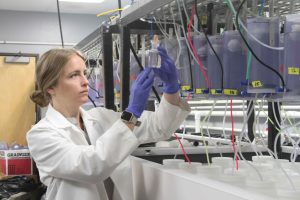Lab experiments completed for study examining multi-stressor effects of changing ocean conditions on Dungeness crab

SCCWRP and its partners have finished a set of laboratory experiments evaluating how Dungeness crab are affected by the combined effects of low dissolved oxygen levels, ocean acidification and warming water temperatures – data that will support an ongoing, multi-year effort to build management tools capable of tracking the biological consequences of climate change on West Coast ecosystems.
The laboratory exposure experiments, completed in September, examined how the three different stressors combine to affect the “breathability” of the ocean water for juvenile Dungeness crab. Previously, researchers had quantified how the ocean’s breathability changes in response to declining oxygen levels and rising water temperatures; this is the first SCCWRP study to assess how declining pH may further alter breathability.
Dungeness crab are one of California’s top commercial fisheries, valued at about $50 million annually.
Researchers are now using the data from the exposure experiments to develop multi-stressor metabolic index tools to help managers track the biological effects of changing ocean conditions along the West Coast.
More news related to: Climate Change, Ocean Acidification and Hypoxia